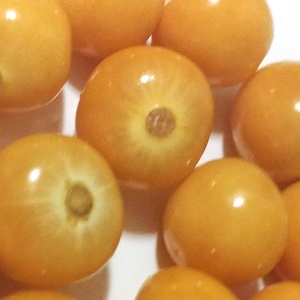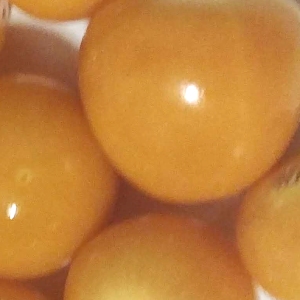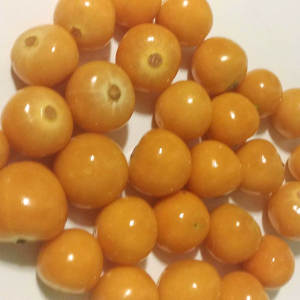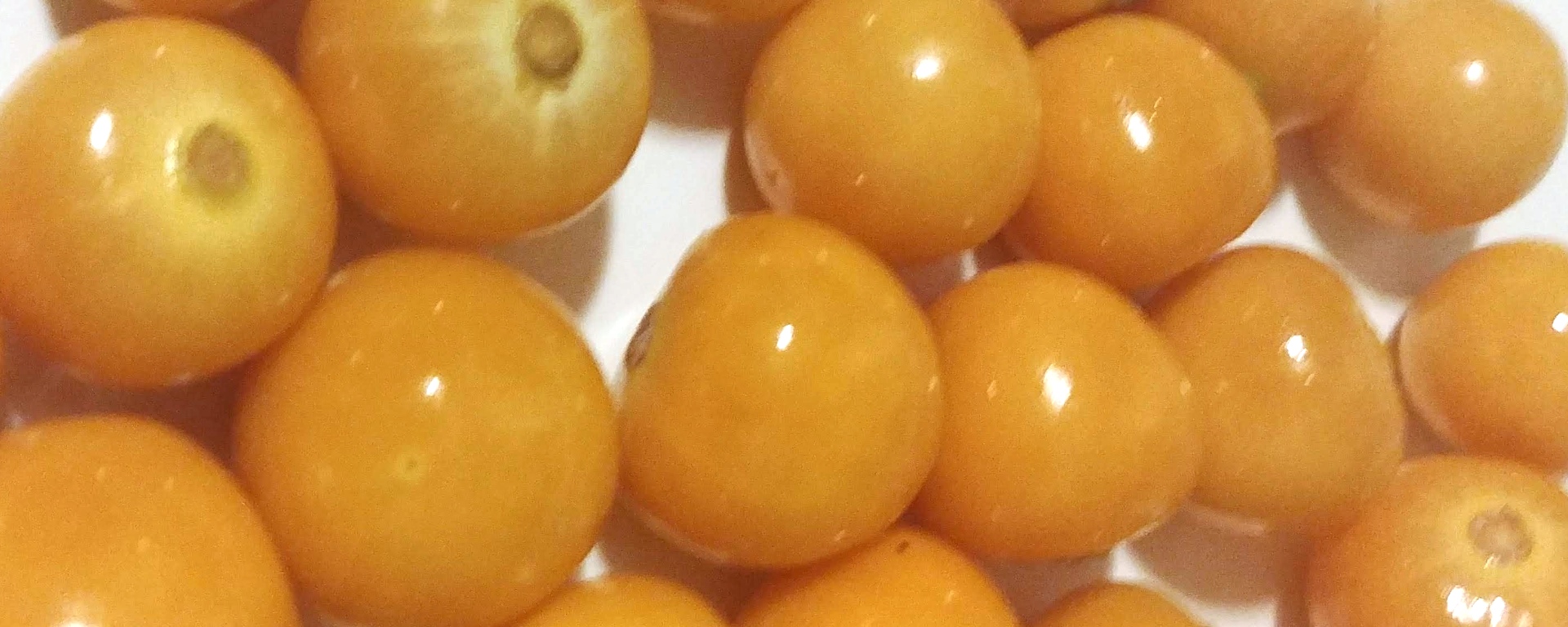What are Cape Gooseberries? Cape Gooseberries (Physalis peruviana) are a nightshade variety of plant that look similar to a cherry tomato except Cape Gooseberries are orange when you remove their husk. These are berries in the very loose sense of the word. In fact, Cape Gooseberries are not to be confused with the common gooseberry. Cape Goosberries are actually a close relative of the tomatillo.
Cape Gooseberries have a light paper-like thin husk around the outside of the fruit to protect them (the same as a tomatillo). However, Cape Gooseberries can be sold with the husk on.. or cleaned off.  When the husk is removed they are a smooth, round berry with golden colored skin holding numerous small pale yellow seeds within, embedded in their pulp.
When the husk is removed they are a smooth, round berry with golden colored skin holding numerous small pale yellow seeds within, embedded in their pulp.
Without a husk, Cape Gooseberries very much resemble orange colored grapes or cherry tomatoes but the flavors couldn’t be more different. Cape Gooseberries are sold under several names which only complicate the mystery around them.
You will see these “fruits” in your market being sold as “Cape Gooseberries”, “Golden Berries”, “Peruvian Ground Cherries”, “Poha Berries”, “Husk Cherry”, “Chinese Lantern” or “Rasbhari”.
What does a Cape Gooseberry taste like?
Cape Gooseberries have a sweet-tart flavor that is kind of like a cross between a cherry tomato and a tart, yet sweet “fruit”. Depending on who you ask, the sweet “fruit” part could be anything from pineapple or mango to strawberry or lemon. I normally will describe the taste like a nice sweet cherry tomato with a cranberry kicker. That kind of thing.
Its best to leave the husk covering on them until they are to be consumed. They’ll store and taste fresh longer this way. When using Cape Gooseberries in recipes, its best to taste them first, as their tartness and sweetness will range from batch to batch.
Can you eat Cape Gooseberries Raw?
Yes, you can eat Cape Gooseberries raw. In fact, when you eat them whole , out of hand, they make a great snack. Cape Gooseberries are often eaten raw in salads either whole, sliced, or quartered. There’s always a twist with nightshades and this one is no different. As a nightshade variety of plant, Cape Gooseberries contain alkaloids (chemicals that cause physiological changes in the body).
Your reaction to these alkaloids may be a positive or negative experience depending on your sensitivity of nightshade varieties of plants. Do you eat tomatoes, peppers, and tomatillos raw without any issues? These are all nightshade varieties of plants. If you have no problem with those, then chances are you’ll have little problem with Cape Gooseberries.
How do you prepare Cape Gooseberries for eating?
Cape Gooseberries are very flexible as a food item and can eaten many ways. Cape Gooseberries can be added to salads just as you would cherry tomatoes. Their high pectin content make them nice candidates for jellies, jams, preserves, compotes, chutneys, and syrups. They’re use in pies, crumbles, and tarts is much the same as you would use other fruits for the same recipes.
Cape Gooseberries can be dried like raisins and eaten by themselves.. or add them to a variety of foods like cereals, oats, yogurt, or salads.  They can also be used just as you would prepare berries in muffins, bread, or cakes. Try Cape Gooseberries dipped in chocolate, icing, or how about blanched, peeled, stuck with a toothpick and rolled in sugar for a bite-sized dessert. Cape Gooseberries are cooked just as you would tomatoes.
They can also be used just as you would prepare berries in muffins, bread, or cakes. Try Cape Gooseberries dipped in chocolate, icing, or how about blanched, peeled, stuck with a toothpick and rolled in sugar for a bite-sized dessert. Cape Gooseberries are cooked just as you would tomatoes.
For instance, you could make a different kind of gazpacho substituting the Cape Gooseberries for the tomatoes. These “berries” can also be canned or dried for extended storage and use.
What pairs well with Cape Gooseberries?
You can pair Cape Gooseberries raw with red grapes, blueberries, apricots or strawberries. Try Cape Gooseberries (raw or cooked) mixed into rice or stuffing. Warm spices such as cinnamon, cardamom, and ginger are very good when looking to dial in a flavor profile for this ingredient. Several herbs go good like parsley and thyme. However, when questioning the viability of adding an herb to Cape Gooseberries, I find that if I would add the herb to a tomato salsa, then it will usually taste good with Cape Gooseberries.
I have friends that serve Cape Gooseberries on cheese platters with cured meats like pepperoni and prosciutto. Come to think of it, pork in general pairs well with Cape Gooseberries. When it comes to wines, I pair my Cape Gooseberries with white wines the same as I do tomatillos. I’ll add Cape Gooseberries along with some raw fennel for a nice twist in any salad.
Cape Gooseberries go well in any salsa. Not just tomato salsas either. I love them in tropical salsas that include ingredients like pineapple or mango. Cape gooseberries pair well with honey and granola. Several nuts are great when served with Cape Gooseberries, such as hazelnuts, walnuts, and pecans.
Are Cape Gooseberries good for you?
That depends. They’re packed with a few nutrients for sure, but as a nightshade variety of plants, that means the plant has alkaloids. Alkaloids act in either a positive or a negative way in the human body physiologically, and some people are more sensitive to these alkaloids than others.  You may not have a problem eating tomatoes but someone else may avoid them because that person correlates migraine headaches with consuming tomatoes.
You may not have a problem eating tomatoes but someone else may avoid them because that person correlates migraine headaches with consuming tomatoes.
If you normally have problems with nightshade plants then you should approach any nightshade variety of plant with caution. Period. These plants can be the source of digestive issues for those with food sensitivities to other nightshades, so its a good idea to know how nightshades, in general, effect you. With that said, these Cape Gooseberries are normally packed with polyphenols and Vitamins A and C. They’re considered to be healthy for you by many and included in the diet because of their antioxidant punch.
Why are they called “Cape” Gooseberries?
“Cape” Gooseberries are named that way because they are thought to originate from the “Cape of Good Hope” in South Africa.Still others maintain that the “Cape” moniker comes from the husk covering or “cape”. Hence another name these are marketed as, the “husk cherry”. They are in fact called, and marketed, as many names so you should know what you’re looking for and looking at, when shopping. Cape gooseberries can be sold under other names like “Golden Berries”, “Peruvian Ground Cherries”, “Poha Berries”, “Chinese Lanterns” or “Rasbhari”.

